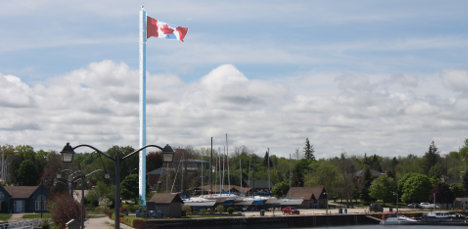By Stephen Vance, Staff

Meaford’s council has found themselves between a rock and a hard place as they consider how best to handle a proposed cell tower in the municipality. At their September 8 meeting, council gave initial approval to a staff report recommending that the municipality enter into a lease with Rogers, who would then install a flagpole cell tower at Meaford’s harbour.
The lease would net the municipality $12,000 per year, and it would ensure that the cell tower is not placed in a residential area, or near a school as had originally been planned.
While council voted 5 – 2 in favour of negotiating a lease with Rogers (Deputy Mayor Harley Greenfield and Councillor Lynda Stephens voted against), some councillors appeared conflicted about how they should vote, and community members who entirely oppose the cell tower attended the meeting in an attempt to steer council away from approving a lease.
The problem faced by council is that should they reject the placement of a cell tower disguised as a flagpole at the harbour, Rogers could very well return to their original plan, which meets all criteria under federal legislation, meaning there is no legal reason to prevent such a decision by Rogers. The flagpole at the harbour was described by some members of council as a compromise by Rogers that the municipality has little choice but to accept.
Vocal opposition to the original proposal, which would have seen Rogers install a cell tower on Edwin Street in close proximity to Georgian Bay Secondary School, focused on potential health effects from such a tower, and a quickly organized opposition group pleaded with council to seek outside assistance before making a decision.
That advice was heeded by council, who directed staff to seek the assistance of the Canadian Radio-communications Information and Notification Service (CRINS).
Todd White of CRINS attended the June 9 council meeting to explain the process that had been undertaken by CRINS, and he explained some of the alternate site options that had been explored in that process. White advised council that in his opinion the best option for the proposed tower would be to locate it at the harbour disguised as a large 30-metre high flagpole.
During his presentation to council White attempted to help residents understand why Rogers is seeking a new tower with upgraded capacity when cell phones and other devices seem to work perfectly fine without a new tower. White explained that while Rogers may have been the first to knock on the door in search of a location for a new cell tower – required in order to support a significant increase in the data usage of devices like cell phones, tablets, and laptop computers – others like Bell and Telus are likely to search for a location in Meaford for new towers which would support upgraded service on a 4G network.
Another reason the cell phone companies will be in search of additional towers is due to Meaford’s geography. The high ridge of land that surrounds Meaford can make it difficult for signals to reach the urban area of the municipality.
While searching for a more suitable location for a new tower, White said that four options were considered, including Lakeview Cemetery, the Meaford Golf Course, Meaford’s water tower, and the harbour area.
In each of the locations considered, proximity to residential areas and schools was still an issue, and some could not provide the coverage required, however the option of a cell tower large flagpole could provide many advantages, according to White.
With a flagpole structure, the number of antenna connections is limited to nine, and the structure is somewhat of a hybrid in that microwave cellular emissions are drastically reduced because fibre-optic wires are incorporated into the design which lessens the need for larger capacity antenna.
While initial approval was given by council to direct staff to negotiate a lease with Rogers for the location at the harbour, some of the yes votes were clearly reluctant votes, which might make for an interesting final vote on the issue at council’s September 22 meeting.
In spite of the visible hesitation for councillors to vote in favour of the proposal, some members of council were comforted by the language that staff has included in the proposed lease agreement, including a provision that notes: “Notwithstanding the foregoing, the Tenant agrees that should the Tenant participate in an expansion of their services through the deployment of small cell technologies, including micro-cell, femto-cell, or other similar technologies, in the area serviced by the Site, the Tenant shall work in good faith with the Landlord to evaluate whether the Site is still required to operate as a macro-site, and will, if feasible, decommission the site’s equipment, or alternatively reduce its output as part of any micro-cell deployment.”











